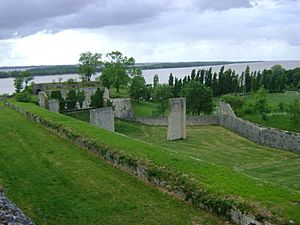Battle of Blaye facts for kids
Quick facts for kids Battle of Blaye (1593) |
|||||||
|---|---|---|---|---|---|---|---|
| Part of the Anglo-Spanish War (1585–1604) and the French Wars of Religion | |||||||
 View of the Gironde Estuary from the ruins of the Citadel of Blaye (2010) |
|||||||
|
|||||||
| Belligerents | |||||||
Supported by: |
|||||||
| Commanders and leaders | |||||||
| Admiral Wilkenson † Vice-Admiral Brailford † Captain Limaille |
Pedro de Zubiaur Joanes de Villaviciosa |
||||||
| Strength | |||||||
| First battle: 6 galleons Supported by: 11–19 to 40–60 French and English ships (Including 6 galleasses) |
First battle: 4 pinnaces Spanish fleet: 16 flyboats and pinnaces |
||||||
| Casualties and losses | |||||||
| 2 galleons sunk (Flagship destroyed) Several ships damaged and 6 English merchant vessels captured |
2 ships burned | ||||||
The Battle of Blaye of 1593 was a big naval victory for Spain. It happened on April 18, 1593, near Blaye in France. This battle was part of a longer, seven-month siege of Blaye.
During this time, Henry of Navarre's French-Protestant forces were fighting against the French-Catholic soldiers defending Blaye. This conflict was part of the French Wars of Religion and the Anglo-Spanish War (1585–1604).
Contents
Why Did the Battle Happen?
In 1592, some ships were bought by Peter Houghton and London merchants. Their goal was to help Marshal Matignon attack Blaye. They also wanted to protect the Gironde area from a Spanish fleet. Six of these ships were English warships. They were led by Admiral Wilkenson and Vice-Admiral Brailford.
The Battle Begins: Spanish Ships Arrive
In April 1593, a Spanish naval force set sail. It had 16 warships, including flyboats and pinnaces. Admiral Pedro de Zubiaur and General Joanes de Villaviciosa Lizarza led this fleet. Their mission was to help the city of Blaye.
Blaye was controlled by the Catholic League of France. But French Royal troops, supported by English and Huguenot forces, were attacking it. Marshal Matignon led these attacking forces. Six English warships, led by Admiral Wilkenson, were blocking the city by sea.
On April 18, the Spanish fleet attacked the English ships. The Spanish ships defeated and scattered the English naval force. Spanish troops then landed at Blaye. This helped the Catholic forces defending the city. During the fight, the English warships of Admiral Wilkenson and Vice-Admiral Brailford were captured and destroyed. Two Spanish flyboats were also sunk.
More Ships Join the Fight
Soon after, another fleet arrived at Blaye. This fleet was made up of 11 to 19 Anglo-French warships from Bordeaux. About 40 smaller vessels, including six galleasses from La Rochelle, also joined them. They tried to block the Spanish fleet.
A fierce battle followed, even during a strong storm. The Spanish ships won this difficult fight. Many lives were lost on both sides due to heavy musket fire. The storm scattered many ships from both fleets. But the Spanish fleet managed to return safely to the port of Pasajes.
After the Battle: A Hero's Reward
King Philip II of Spain honored Pedro de Zubiaur for his bravery. He received a special title for his actions in the battle.
Later, on July 14, another Spanish force arrived. It had six pinnaces and 120 soldiers. Joanes de Villaviciosa Lizarza led the ships. Captain Antonio Manrique de Vargas led the soldiers. They sailed from the Basque port of Castro Urdiales. Their goal was to strengthen the Catholic forces in Blaye.
The Spanish troops under Villaviciosa attacked the Protestant positions. Over 800 Protestants were killed or wounded. After this, the siege of Blaye finally ended. The French-Protestant troops had to leave.
See also
 In Spanish: Batalla de Blaye para niños
In Spanish: Batalla de Blaye para niños
- Battle of Craon
- Battle of the Bay of Biscay (1592)
- Siege of Fort Crozon
- Battle of Cornwall
- French Wars of Religion
- Catholic League of France

